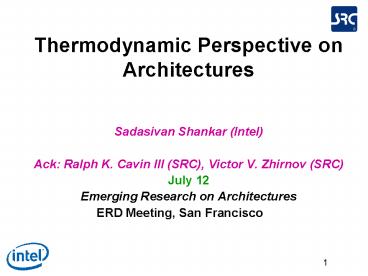Thermodynamic Perspective on Architectures - PowerPoint PPT Presentation
1 / 8
Title:
Thermodynamic Perspective on Architectures
Description:
Thermodynamic Perspective on Architectures Sadasivan Shankar (Intel) Ack: Ralph K. Cavin III (SRC), Victor V. Zhirnov (SRC) July 12 Emerging Research on Architectures – PowerPoint PPT presentation
Number of Views:92
Avg rating:3.0/5.0
Title: Thermodynamic Perspective on Architectures
1
Thermodynamic Perspective on Architectures
- Sadasivan Shankar (Intel)
- Ack Ralph K. Cavin III (SRC), Victor V. Zhirnov
(SRC) - July 12
- Emerging Research on Architectures
- ERD Meeting, San Francisco
2
Main Points
- We have developed a general methodology for
applying thermodynamic principles for information
engines like the Carnot principle to heat engines - More fundamental than simplistic capacitance
based formalism currently being used - The operating limit of 104 kT is possibly due to
quantum state, architecture, and layout - Two applications
- Similar to heat engines, will identify the ideal
Compute Engine Carnots Compute Engine for
ideal computing. This would serve as a limiting
case for realistic architectures - Estimate efficiencies for different architectures
based on physics - Layout efficiency
- Energy efficiency
- Potential trade-off between layout and energy
- Continue work on estimating minimum energy needed
of various simple systems
3
Computing Engine Premise
Heat Engine
Computing Engine
- Similar to a heat engine, a computing engine can
be visualized - Goal is to use thermodynamics, which incorporates
relations between systems components and
determines the most energy efficient systems
4
A Perspective on Layout
- Ideal layout based on a single switch
- Interconnects and isolation may be driving in
real systems
5
Entropy of a Single Switch System (1)
- Entropy is determined by statistical mechanics
Switching state
Quantum States
Nit Nit 2 is bit, Nit 4 is qit etc. kB -
Boltzmann constant N number of states in the
system (1 for single state switching) Et Total
Energy is estimated from statistical mechanics Z
Partition function
Switching Energy
Total energy
6
Free Energy of a Single Switch System
- Free energy is determined by thermodynamics
7
Simple Illustration
- For a binary switch, the minimum energy is
determined by the need to maintain binary
transition (bit) and energy of the particle in an
isolated level - For a classical switch, the following are the
limits
Example Micro-Systems Bits N Pi EMin
Binary 1 D2/8a2 1/2N kT log 2
Inverter 1 D2/12a2 1/2N kT log 2
NOR 2 D2/24a2 1/4N 2kT log 2
NAND 2 D2/16a2 1/4N 2kT log 2
6-T SRAM 16 D2/48a2 1/216N 16kT log 2
- EMin is idealistic and is determined by the bits
processed in the micro-systems
8
Ideal Architecture Comparison A Simple
Illustration
U 4 (14 x 10) Nit 16, 16, 16,16
U 8 (10 x 12) Nit 2, 2, 2, 2
- For an ideal classic switch, reducing minimum
energy seems to be driven by U more than Nit (due
to log Nit dependence) - Indicates that fewer larger units with larger
bits processed in each lower free energy for a
classical switch - Other factors not considered
- Interconnects, dissipation, functionality of
architecture, unit layout, software, .































